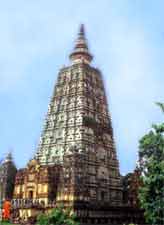|
Ashoka Pillars and Buddhist Sculptures
 The finest monolithic pillars of Ashoka is the lion crowned pillar
at Lauriya, Namdangarh in Champaran, which consists of a polished block
of sandstone 10.1 metres long with a capital nearly 2.13 metres in length.
Two other inscribed pillars are found
at Rampurwa and Laurya at Basark. All four were set up on the imperial
road from Pataliputra to Nepal. The edicts of the emperor are inscribed
on rock at the Dhauli Hill in Orissa and on a hill near Sasaram in Bihar.
The finest monolithic pillars of Ashoka is the lion crowned pillar
at Lauriya, Namdangarh in Champaran, which consists of a polished block
of sandstone 10.1 metres long with a capital nearly 2.13 metres in length.
Two other inscribed pillars are found
at Rampurwa and Laurya at Basark. All four were set up on the imperial
road from Pataliputra to Nepal. The edicts of the emperor are inscribed
on rock at the Dhauli Hill in Orissa and on a hill near Sasaram in Bihar.
Buddhistic statuary of a later date is common in the
Gaya district with the exception of Graeco-Buddhistic sculptures of Gandharva.
These images are the only class of Indian Buddhist art that has come down
through ages in a fair state of completeness. At Bodh Gaya, the oldest
Buddhist memorial is a stone railing ornamented with friezes, panels and
bosses, which display considerable artistic skill. The temple is 55 metres
high. It is a modern restoration carried out by the Government. It has
a large collection of Stupas
which the pilgrims to this holy land left as memorials for their visit.
The stupa was originally a copy in brick or stone of an earthen sepulchral
tumulus and ending with the ornamented spire of the medieval period.
|

